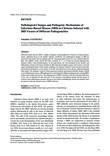Pathological Changes and Pathogenic Mechanisms of Infectious Bursal Disease (IBD) in Chickens Infected with IBD Viruses of Different Pathogenicities
JARQ : Japan Agricultural Research Quarterly
| ISSN | 00213551 |
|---|---|
| 書誌レコードID(総合目録DB) | AA0068709X |

本文フルテキスト
jarq56-1_33-40.pdf810.27 KB
Infectious bursal disease (IBD), a highly contagious immunosuppressive disease in young chickens, causes significant losses to the poultry industry worldwide. The pathological changes in IBD are reviewed in this study. Oral inoculation with 105.5 mean egg infective dose of a very virulent Ehime/91 IBD virus (IBDV) strain caused 40%-60% mortality in 3- to 4-week-old specific-pathogen-free chickens within 5 days postinoculation. In the acute phase, the virus produced severe necrotic and inflammatory lesions in the bursa of Fabricius (BF) and other lymphatic organs, bone marrow, and vital organs including the lungs. Under similar conditions, the classical virulent J1 strain caused no mortality and produced moderate to severe lesions in the BF and mild lesions in the thymus without damaging other organs. The antigenic variant-E strain caused no mortality and induced rapid BF atrophy without severe inflammatory lesions. IBD pathogenesis is determined by different pathogenicities among IBDV isolates and variable host factors. The pathogenicity of IBDV correlates with the replication efficiency of the virus in immature B cells and cells of the monocyte–macrophage lineage and the degree of systemic acute inflammatory reaction. Moreover, host factors including age, breed, and immune status are known to alter the clinical course of IBDV infection.
| 刊行年月日 | |
|---|---|
| 作成者 | Nobuhiko TANIMURA |
| 著者キーワード | clinical signs gross lesions histopathology |
| 公開者 | Japan International Research Center for Agricultural Sciences |
| 受付日 | 2021-01-05 |
| 受理日 | 2021-03-10 |
| オンライン掲載日 | |
| 巻 | 56 |
| 号 | 1 |
| 開始ページ | 33 |
| 終了ページ | 40 |
| 言語 | eng |
